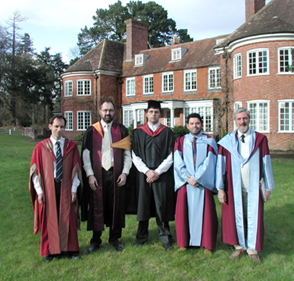Electromagnetic Modelling of the Human Body Exposed to Extremely Low Frequency (ELF) Electric Field
 Silvestar Sesnic graduated from the University of Split, Croatia and has recently successfully passed his MPhil Viva at WIT with a thesis on “Electromagnetic Modelling of the Human Body Exposed to Extremely Low Frequency (ELF) Electric Field”. The external examiner was Prof Francesco Lattarulo from the Department of Electronics and Electrical Engineering at the University of Bari, Italy and the internal was Dr Andres Peratta. Grateful acknowledgement is given to the British Council for their support. The objective of the research was to develop some useful analytical models of the human body exposed to power line electric fields.
Silvestar Sesnic graduated from the University of Split, Croatia and has recently successfully passed his MPhil Viva at WIT with a thesis on “Electromagnetic Modelling of the Human Body Exposed to Extremely Low Frequency (ELF) Electric Field”. The external examiner was Prof Francesco Lattarulo from the Department of Electronics and Electrical Engineering at the University of Bari, Italy and the internal was Dr Andres Peratta. Grateful acknowledgement is given to the British Council for their support. The objective of the research was to develop some useful analytical models of the human body exposed to power line electric fields.
The equations for calculating electric and magnetic fields emitted by three-phase, three-wire power line, configuration which are used by many electro-distribution companies, are outlined in the thesis. Later calculations are preformed with these results. Techniques for measurements of low frequency electric and magnetic fields are presented, with the description of the latest measuring instruments. Guidelines and standards in protection against harmful exposure to electromagnetic fields are presented, with the emphasis on ICNIRP guidelines.
The main part of the thesis is dealing with analytical approximations of the human body. Cylindrical approximation is based on a theory of receiving antenna and presentation of the human body as a parasitic antenna exposed to an incident electric field. Through cylindrical approximation, the induced current inside the human body is calculated. This current is used for evaluating adverse health effects that the electric field has on the human body. Different cases of exposure are considered, taking into account insulation between the human body and the earth. Ellipsoidal approximation is used as a comparison to cylindrical.
Finally, Silvester gave the comparison with the numerical model based on the Boundary Element Method (BEM) and the results obtained are shown to be in very good agreement.
The comparison with the ICNIRP guidelines and the Croatian law for the protection from non-ionizing radiation is made and it is shown that the acquired results are well bellow all the limitations.
Silvestar presented a very good MPhil thesis and as a result of his research both examiners recommended the award of Master of Philosophy. Silvestar is now returning to Split, Croatia where he is to further his academic career as a young researcher at the University
This programme was supported through the Chevening Scholarship Scheme.


 Wessex Institute
Wessex Institute